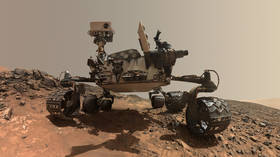Life on Mars: Organic molecules discovered by Red Planet rover offer major hint

NASA’s Curiosity rover has scooped up interesting organic compounds on the surface of Mars, which hint that early forms of life could be present on the Red Planet.
The car-sized machine has been trundling around Mars’ Gale crater for over seven years now. It has beamed back all sorts of fascinating images during its time investigating the planet’s rocky surface. However, its unearthing of some simple organic compounds may be its most important discovery yet.
The compounds, which are called thiophenes, are found on Earth in coal, crude oil and, strangely enough, in white truffles, the mushroom that’s the darling of the fine food scene.
Also on rt.com Ancient aliens? NASA’s Mars 2020 mission landing site could contain fossilized signs of lifeA new study has postulated that their discovery on Mars is consistent with the presence of early life on the planet. The research suggests that a biological process, most likely involving bacteria, may have played a role in the organic compound’s presence in the Martian soil.
The Washington State scientists found that ancient bacteria, which may have existed more than three billion years ago when Mars was warmer and wetter, could have facilitated a chemical process that results in thiophenes. There are also other pathways, in which the thiophenes themselves are broken down by bacteria.
However, the scientists cannot rule out the possibility that some other non-biological process led to the compounds appearing on Mars. One possible explanation is that they were ferried there on a meteor that landed on the planet.
“We identified several biological pathways for thiophenes that seem more likely than chemical ones, but we still need proof,” astrobiologist Dirk Schulze-Makuch, one of the researchers, explained. “If you find thiophenes on Earth, then you would think they are biological, but on Mars, of course, the bar to prove that has to be quite a bit higher.”
Also on rt.com Rosebud or Mars shroom? Strange structure on Red Planet puzzles UFO hunters (VIDEO)It may be possible to get further evidence when the next rover, the Rosalind Franklin, touches down on Mars. The mobile science lab is expected to launch in July 2020 and it will be carrying a Mars Organic Molecule Analyzer, or MOMA, which will be able to collect larger molecules than Curiosity can.
However, Schulze-Makuch says, even that mightn’t be enough evidence because of the magnitude of the claim.
“As Carl Sagan said ‘extraordinary claims require extraordinary evidence… I think the proof will really require that we actually send people there, and an astronaut looks through a microscope and sees a moving microbe.”
Like this story? Share it with a friend!












